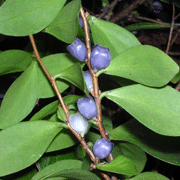James L. Luteyn and Paola Pedraza-Peñalosa
The New York Botanical Garden
THEMISTOCLESIA
|
|
Themistoclesia is a genus of ca. 25 species, ranging from Costa Rica and Panama and through the Andes from Venezuela into northern Bolivia. It is characterized by a non-articulate calyx, with a winged or angled hypanthium. |
THEMISTOCLESIA Klotzsch, Linnaea 24: 41. 1851; Smith, Contr. U.S. Natl. Herb. 28: 439-444. 1932; Sleumer, Notizbl. Bot. Gart. Mus. Berlin-Dahlem 13: 108-111. 1936; Luteyn, Fl. Ecuador 54: 370-380. 1996. Lectotype: Themistoclesia pendula Klotzsch [=Themistoclesia dependens (Bentham) A.C. Smith].
Straggly to bushy, often epiphytic shrubs or shrublets. Leaves alternate, subcoriaceous to coriaceous, occasionally thick-fleshy, obscurely plinerved or rarely pinnate, short-petiolate. Inflorescence axillary, fasciculate, racemose, or flowers solitary; pedicel usually inconspicuously bibracteolate. Flowers (4-) 5-merous, without odor; aestivation valvate; calyx continuous with the pedicel (although seemingly articulate in T. alata); hypanthium obconic or short-cylindric, strongly winged (T. alata and T. pentandra) or bluntly angled; limb erect to slightly spreading; lobes acute to acuminate, minute to well developed; corolla ovoid to cylindric, terete or angled but not winged; stamen 4-5 or 8-10, equal or alternately slightly unequal, more than 1/2 as long as the corolla and often about as long as the corolla tube; filaments distinct, slender and terete to somewhat flattened at the base, lacking spurs; anthers inserted medially or almost basally, lacking disintegration tissue; thecae smooth; tubules nearly equal to or about two times longer than the thecae, generally 2 and separate, rarely 1 by fushion, dehiscing by short, introrse clefts; pollen lacking viscin threads; nectariferous disc annular-pulvinate, glabrous or hispid; ovary inferior; style filiform, about as long as the corolla. Fruit a berry; seeds numerous, small, the embryo green and clearly visible through the surrounding tissue.
Key to Neotropical Species Back to Top
A key is not currently available.
This web version has been modified from Luteyn 1996b and unpublished notes, but a treatment is still lacking.
